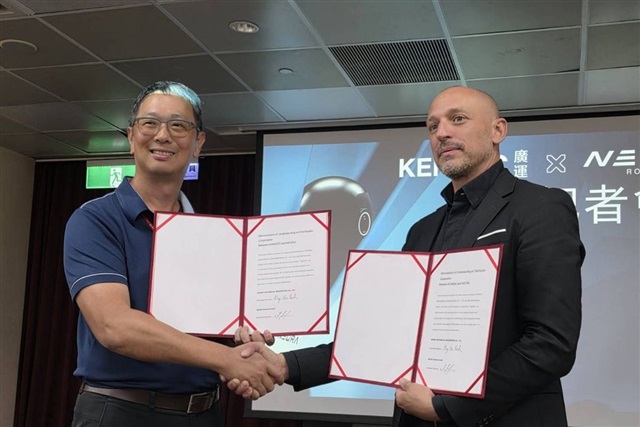Kenmec Mechanical Engineering has entered into an exclusive agency agreement with German humanoid robot startup Neura Robotics to enhance intelligent in-factory logistics, with an initial focus on automating semiconductor back-end processes. The partnership aims to provide automation solutions to address labor-intensive tasks in packaging and testing.
Kenmec chairman Kevin Hsieh said the collaboration enables the company to complete the last mile in intelligent logistics manufacturing, positioning Kenmec to support semiconductor customers in gaining early operational advantages. Kenmec president Chih-Chun Ko emphasized that while front-end semiconductor manufacturing is highly automated, back-end processes remain largely manual due to the diversity and irregularity of items handled, presenting challenges and high labor costs in certain regions.
Kenmec's approach combines its expertise in automated guided vehicles (AGV) and autonomous mobile robots (AMR) with Neura's robotic arms equipped with visual and voice control capabilities. These arms, capable of precise identification and handling of scattered objects, deliver materials directly to equipment stations, effectively replacing manual labor and enhancing operational efficiency. This is especially relevant for semiconductor plants located in Europe, the US, Japan, and elsewhere.
The cooperation reflects a strategic integration of Kenmec's field application experience in smart manufacturing and logistics with Neura's AI robotics and perception technologies. Their collaboration extends further by incorporating Germany's Schunk dexterous hand technology, resulting in a multinational ecosystem that enables seamless interaction among AGVs, AI robotic arms, and precision handling tools.
Ko projected that Kenmec expects semiconductor-related orders and revenue to more than double year-on-year by 2025, driven by strong sector demand. The company plans to launch the collaboration's solutions in Taiwan initially before expanding to overseas markets, particularly targeting Taiwanese manufacturers establishing operations in the US and Southeast Asia. The localized automation offerings aim to mitigate labor shortages and high labor costs, helping clients maintain competitive advantages globally.
Kenmec is known for customized smart system integration, project management, and recently advancing humanoid robots through its self-developed AGF unmanned transport vehicle technology. Neura Robotics' product line includes the humanoid robot 4NE-1, service robot MiPA, AI cognitive arm MAiRA, and AI collaborative arm LARA. Neura also develops the Neuraverse platform, designed to connect global developers, data, and applications to support real-time simulation, scalable AI models, and device ecosystems for intelligent automation research and development.
Kenmec and Neura complement each other's technology to advance semiconductor smart manufacturing opportunities
On August 20, Kenmec Mechanical Engineering signed an exclusive agency cooperation agreement with German humanoid robot startup Neura Robotics. Kenmec Chairman Hsieh Ming-kai stated that this collaboration enables Kenmec to complete the last mile in intelligent in-factory logistics manufacturing, positioning it strategically to help semiconductor clients seize early advantages.
Kenmec General Manager Chih-chun Ko further explained that their partnership will initially focus on providing automation solutions for the semiconductor back-end processes. Although front-end semiconductor manufacturing is already highly automated, back-end stages such as packaging and testing still rely heavily on manual labor due to diverse objects and irregular shapes. This not only consumes time and effort but also becomes a significant burden in regions with high labor costs.
Kenmec's solution integrates its expertise in automated guided vehicles (AGV) or autonomous mobile robots (AMR) with Neura's robotic arms equipped with perception capabilities. These robotic arms feature visual and voice control functions, enabling precise identification and handling of scattered items, delivering them directly to equipment stations. This effectively replaces traditional manual labor and significantly enhances overall operational efficiency—especially valuable for semiconductor manufacturers operating plants in Europe, the US, Japan, and other locations.
The cooperation between Kenmec and Neura goes beyond a simple agency relationship, representing a deep complementary synergy based on their respective strengths.
First, it is a perfect fusion of experience and technology. Kenmec contributes extensive "field application experience" accumulated in smart manufacturing and logistics, while Neura provides "AI robotics and perception technology." The combination of these two core elements forms a comprehensive solution.
Second, they are building a multinational, multi-party ecosystem. This solution extends beyond just Kenmec and Neura, incorporating Germany's Schunk precision dexterous hand technology. Such cross-border and cross-domain technological integration allows seamless collaboration among AGVs, AI robotic arms, and dexterous hands, creating an automated system capable of handling the most complex tasks.
Ko revealed that Kenmec expects more than double year-on-year growth in both semiconductor orders and revenue by 2025. This robust momentum mainly stems from strong demand within the semiconductor sector. These impressive figures not only validate Kenmec's forward-looking strategy but also demonstrate how cooperation with Neura will rapidly translate into tangible benefits.
Kenmec plans to start from Taiwan and gradually expand this successful model overseas. Besides focusing on Southeast Asia, they specifically target Taiwanese companies establishing factories in the US and other regions, offering localized automation solutions to address challenges like labor shortages and high labor costs, thereby helping maintain competitiveness in global markets.
Kenmec excels in customized smart system integration and project management, assisting clients in implementing applications such as smart warehousing, manufacturing, logistics, and airborne semiconductor transport. In recent years, they have leveraged self-developed AGF unmanned transport vehicle technology to promote humanoid robots toward practical use as a new generation of intelligent hubs.
Germany's Neura Robotics product line includes the humanoid robot 4NE-1, the service robot MiPA, AI cognitive arm MAiRA, and AI collaborative arm LARA. They are advancing the Neuraverse development platform to integrate global developers, data, and applications, providing real-time field simulation, scalable apps, AI models, and device ecosystems to create a one-stop R&D environment for intelligent automation.
Article edited by Jack Wu




